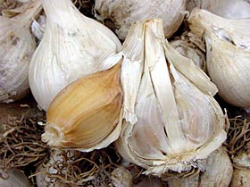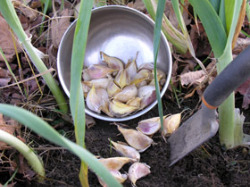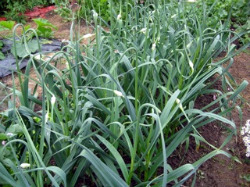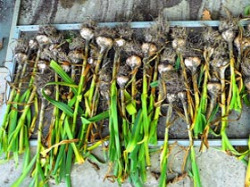
Purchase garlic bulbs from the garden center or through the mail. Grocery store garlic varieties usually aren't adapted to grow well in most climates.

Plant garlic cloves around the first fall frost in your area.
The "stinking rose" has been grown for thousands of years for its flavor and medicinal properties. Raw garlic is touted as being a cure for everything from the common cold to high cholesterol to an abundance of vampires. (Watch out Twilight fans.) But it's mostly grown for its flavor. The spicy taste of garlic cloves is used in ethnic dishes from Asia to South America, flavoring stir fries, salsa, salads, and a variety of meat and vegetable dishes. The flavor varies depending on the variety. Some varieties have a spicy hot flavor while others are milder.
Whatever variety you decide to grow, make sure it's adapted to conditions in your climate. Garlic found in grocery stores is most likely from California (or, these days, China) and will be best adapted to that climate. It's best to purchase garlic from local garden centers or through the mail, finding the varieties best suited to your region.
There are three types of garlic available. Hardneck varieties such as 'Russian Red' and 'German Extra Hardy', have 5 to 10 cloves per bulb and the plant forms an edible scape (curly flower stalk) in early summer with small garlic bulblets at the top. They will last up to 6 months in storage. Softneck varieties, such as 'New York White' and 'Silverskin', produce 12- to 18-cloves per bulb and have a soft leaves that are easy to braid after harvesting. They last longer in storage than hardneck varieties (up to 9 months). A third, less common type, is elephant garlic. Elephant garlic is more closely related to leeks than garlic. It's a giant form of softneck garlic with plants growing up to 4 feet tall. They produce 4 large cloves per bulb. The flavor is milder than other garlics and they store well.
PlantingUnlike most other vegetables, garlic is best planted in fall. In cool climates you can plant in spring, but the bulbs will be noticeably smaller. In warm winter areas you can plant right up until January. In most other areas, plant garlic cloves around the time of your first frost date (about 4 to 6 weeks before your ground freezes). That would be October and November for most of the country. Garlic grows best in cool weather. Plants will establish root systems in fall and start growing in spring with warmer weather. You'll be harvesting in June or early July. Here's how to plant.

Hardneck garlic varieties will produce a scape that is edible and should be removed for best bulb production.

Save the biggest garlic bulbs from last year for planting again in fall.
Growing Great Garlic
A Passion for Garlic
Glorious Garlic
 Charlie Nardozzi is an award winning, nationally recognized garden writer, speaker, radio, and television personality. He has worked for more than 30 years bringing expert gardening information to home gardeners through radio, television, talks, tours, on-line, and the printed page. Charlie delights in making gardening information simple, easy, fun and accessible to everyone. He's the author of 6 books, has three radio shows in New England and a TV show. He leads Garden Tours around the world and consults with organizations and companies about gardening programs. See more about him at Gardening With Charlie.
Charlie Nardozzi is an award winning, nationally recognized garden writer, speaker, radio, and television personality. He has worked for more than 30 years bringing expert gardening information to home gardeners through radio, television, talks, tours, on-line, and the printed page. Charlie delights in making gardening information simple, easy, fun and accessible to everyone. He's the author of 6 books, has three radio shows in New England and a TV show. He leads Garden Tours around the world and consults with organizations and companies about gardening programs. See more about him at Gardening With Charlie.
 Victory Seed Company has all the seeds you want for your best garden in 2024.
Victory Seed Company has all the seeds you want for your best garden in 2024.
For 25 years, the family-owned Victory Seed Company has provided the highest quality vegetable, herb and flower seeds to families across the country. We are passionate about providing you the best seeds available that give excellent germination, robust plants, and the harvest you want. With a catalog of over a thousand varieties, we have everything, and our prices are the kinds that we'd want to pay. We have hundreds of yesterday's heirloom vegetables, as well as today's award winning hybrid selections. Get to know us by visiting our website and browsing through our online vegetable seed catalog.